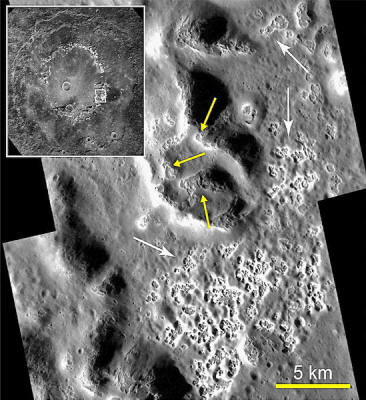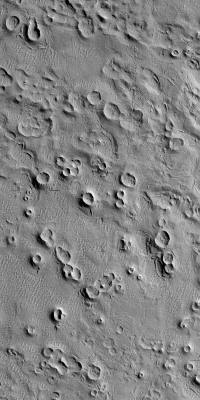|

by Stephen Smith
October 30, 2011
from
Thunderbolts Website
|
Data from the
MESSENGER probe to Mercury continues to provide evidence
for the Electric Universe theory. |

Inside Raditladi
Basin on Mercury
Credit: AAAS/Science
Data from the
MESSENGER probe to Mercury
continues to provide evidence for the
Electric Universe theory.
The planet Mercury has no atmosphere and little in the way of a
magnetic field, so it is bombarded by the full force of the Sun’s
radiation. Since the Moon is also an airless world, with only traces
of a magnetic field, perhaps explanations applicable to the Moon or
Mars might help to explain Mercury’s features.
The recent image of
Raditladi Basin is a case in point.
The Moon is 3472 kilometers in diameter and Mercury is 4878
kilometers in diameter, their surfaces are almost identical in
appearance. The lack of atmosphere and low gravity contribute to a
lack of erosion on both bodies, but the various formations on both
reveal a high level of congruency.
The surfaces of the Moon and Mercury are
also composed primarily of basalt, the most common mineral in the
Solar System.
According to a recent
press release, an,
“unexpected class of landform on
Mercury” has been found, suggesting a “previously unrecognized
geological process is responsible for its formation.”
It is not surprising that the processes
that create the topography in question remain puzzling to planetary
scientists:
the features are reminiscent of
formations on the Moon, particularly the Ina Structure
(below image).

Apollo
photographs of the D-shaped Ina structure.
It is 2.8 km in
diameter and 60 m in depth.
Main panel, the
closer view from the Apollo 15 panoramic camera
shows the absence
of small craters on the interior of the feature and the sharp
contacts
between smooth
mounds of low relief and brighter, hummocky floor.
Stereo-photogrammetry
demonstrates that the larger smooth mounds can be as high as 25
m,
but there are
numerous smaller relief features including scarps and floor
rubble (bright areas)
extending to
below the available resolution (<5 m). Inset, a low-illumination
view
(taken with an
Apollo hand-held camera) showing the depression (scale bar, 400
m).
Mars might also figure into the discussion when the
hollowed out mounds (below image) on the flanks of Olympus Mons
are considered.

“Small, shallow, irregularly shaped
depressions that are often found in clusters,” could be a
defining characteristic of electric spark machining on a
conductive surface, rather than the remains of volcanic vents,
or places where trapped subsurface gases have erupted under
pressure.
One key to their understanding might lie
in the brightness of the ridges within the “hollows.”
On Venus, the bright tops of mountains were theorized to be due to
something like
St. Elmo’s fire playing across the
peaks. Since plasma is highly reflective of radar light, and the
surface of Venus was mapped using radar to penetrate the clouds, the
conjecture seems logical considering Electric Universe ideas.
Since MESSENGER is using a
multi-spectral high resolution imaging system, the bright ridges are
most likely due to chemical changes from intense plasma discharges.
When basalt is baked, it releases gases that cause it to turn from a
dark color to a light color. It might be that electric arcs
excavated the depressions with white hot ion beams, hardening and
lightening the surface.
Similar processes could also be
responsible for the comparative formations on the Moon and Mars.
Mercury is believed to be almost 75% iron surrounded by a thin shell
of silicon-rich rock. Conventional theories of planet formation have
no explanation for such a configuration. If it formed in the same
protoplanetary nebula as the rest of the Solar System, then the
abundance of iron remains a mystery because the ratio of iron to
silicon is opposite to the other rocky planets.
Mercury is thought to have a molten core
generating a magnetic field (below image), but no one knows if it is
working like Earth’s is supposed to work or if the field is part of
the crust, like Mars.
No one understands how a molten core
exists on Mercury since the planet appears cold and dead.

The molten interior should have cooled
off eons ago.
As Electric Universe proponent Wal Thornhill
wrote:
“In Mercury’s case, its strong
gravitational field for its size indicates a high level of
internal electrical polarization. That means a high surface
charge. So Mercury’s slowly rotating charge will produce a small
magnetic field. Other effects will modify that field.
For example, currents flow in the
plasma above the surface and are induced in the surface of the
planet. And there is remanent magnetism associated with old
cosmic thunderbolt surface scars.”
|




